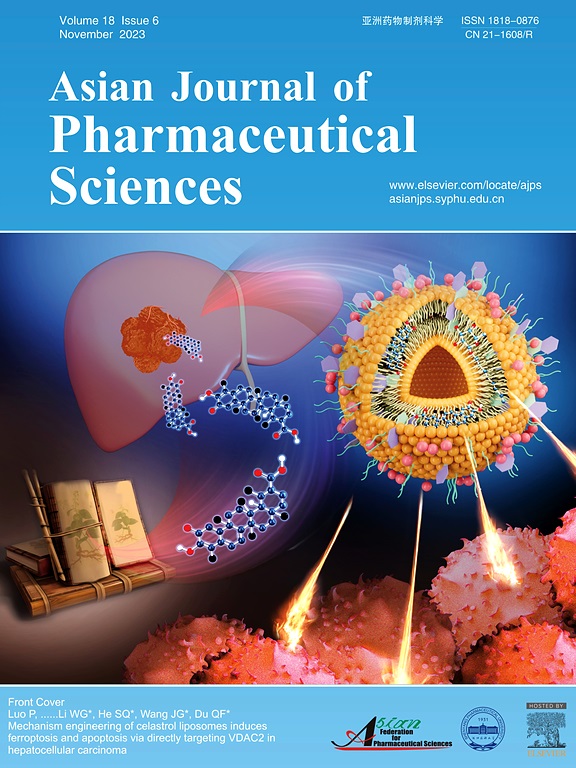Extracellular vesicles as delivery vehicles and therapeutic agents for glioblastoma treatment: A systematic review of in vitro and in vivo preclinical studies
IF 10.7
1区 医学
Q1 PHARMACOLOGY & PHARMACY
引用次数: 0
Abstract
Current treatments for glioblastoma face challenges such as the blood-brain barrier and lack of targeted therapy, compounded by the aggressive nature, high invasiveness, and heterogeneity of the disease. Exosomes, a subtype of extracellular vesicles are emerging as promising nanocarrier drug delivery systems to address these limitations. Exosomes released by all cell types can be easily obtained and modified as delivery vehicles or therapeutic agents. A systematic review was conducted to evaluate various methods for exosome isolation, characterization, engineering or modification, drug loading and delivery efficiency, including exosome biodistribution and treatment efficacy. A search of four databases for in vitro and in vivo studies (2000–,2023) identified 6165 records, of which 23 articles were found eligible and included for analyses. Most studies applied ultracentrifugation (UC) for exosomes isolation. Cancer cell lines being the most frequently used source of exosomes, followed by stem cells. The incubation approach was predominantly utilized to modify exosomes for drug loading. In vivo analysis showed that exosome biodistribution was primarily concentrated in the brain region, peaking in the first 6 h and remained moderately high. Compared to native exosomes and untreated control groups, utilizing modified native exosomes (cargo loaded) for treating glioblastoma disease models led to more pronounced suppression of tumor growth and proliferation, enhanced stimulation of immune response and apoptosis, effective restoration of drug chemosensitivity, increased anti-tumor effect and prolonged survival rates. Modified exosomes whether through incubation, sonication, transfection, freeze-thawing or their combination, improve targeted delivery and therapeutic efficacy against glioblastoma.

细胞外囊泡作为胶质母细胞瘤治疗的运载工具和治疗剂:体外和体内临床前研究的系统综述
目前胶质母细胞瘤的治疗面临着诸如血脑屏障和缺乏靶向治疗等挑战,加上该疾病的侵袭性、高侵袭性和异质性。外泌体是细胞外囊泡的一种亚型,作为一种有前途的纳米载体药物递送系统正在出现,以解决这些限制。所有细胞类型释放的外泌体都可以很容易地获得并作为递送载体或治疗剂进行修饰。系统综述了外泌体分离、表征、工程或修饰、药物装载和递送效率的各种方法,包括外泌体的生物分布和治疗效果。检索了四个体外和体内研究数据库(2000 - 2023),确定了6165条记录,其中23篇文章符合条件并纳入分析。大多数研究采用超离心(UC)分离外泌体。癌细胞系是最常用的外泌体来源,其次是干细胞。孵育方法主要用于修饰外泌体以装载药物。体内分析表明,外泌体的生物分布主要集中在大脑区域,在前6小时达到峰值,并保持中等水平。与天然外泌体和未经治疗的对照组相比,利用修饰的天然外泌体(装载货物)治疗胶质母细胞瘤疾病模型可更明显地抑制肿瘤生长和增殖,增强免疫反应和细胞凋亡的刺激,有效地恢复药物化疗敏感性,增强抗肿瘤效果,延长生存率。修饰的外泌体无论是通过孵育、超声、转染、冷冻解冻还是它们的联合使用,都能提高胶质母细胞瘤的靶向递送和治疗效果。
本文章由计算机程序翻译,如有差异,请以英文原文为准。
求助全文
约1分钟内获得全文
求助全文
来源期刊

Asian Journal of Pharmaceutical Sciences
Pharmacology, Toxicology and Pharmaceutics-Pharmaceutical Science
CiteScore
18.30
自引率
2.90%
发文量
11
审稿时长
14 days
期刊介绍:
The Asian Journal of Pharmaceutical Sciences (AJPS) serves as the official journal of the Asian Federation for Pharmaceutical Sciences (AFPS). Recognized by the Science Citation Index Expanded (SCIE), AJPS offers a platform for the reporting of advancements, production methodologies, technologies, initiatives, and the practical application of scientific knowledge in the field of pharmaceutics. The journal covers a wide range of topics including but not limited to controlled drug release systems, drug targeting, physical pharmacy, pharmacodynamics, pharmacokinetics, pharmacogenomics, biopharmaceutics, drug and prodrug design, pharmaceutical analysis, drug stability, quality control, pharmaceutical engineering, and material sciences.
 求助内容:
求助内容: 应助结果提醒方式:
应助结果提醒方式:


